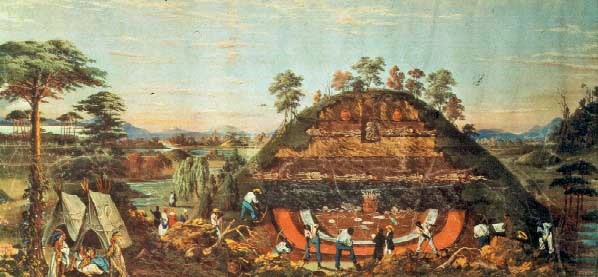Zelph Lamanite Mound
The appearance of the Zelph mound is identical to those found in the Ohio Valley, which is loaf shaped with a top that is tapered. This type of mound is associated with the Hopewell mound builders, who were a confederacy of the Sioux, Cherokee and Iroquois. This is consistent with McBride's account that stated, His name was Zelph a warrior under the Prophet Onandagus Zelph a white Lamanite."
Diagrammed is the Harness Mound that was centered in the Liberty Earthwork in Chillicothe, Ohio. Note the loaf shape and tapered top that provides descent evidence that the builders of these two mounds were the same people.
Howe's 1834 anti-Mormon book Mormonism Unveiled, which states:
A large mound was one day discovered, upon which Gen. Smith ordered an excavation to be made into it; and about one foot from the top of the ground, the bones of a human skeleton were found, which were carefully laid out upon a board, when Smith made a speech, prophesying or declaring that they were the remains of a celebrated General among the Nephites, mentioning his name and the battle in which he was slain, some 1500 years ago.
Contrary to Howe's statement that the group found the remains of a "General among the Nephites," all of the recorded accounts agree that Zelph was identified as a Lamanite.
Heber C. Kimball wrote in 1841 that several of the group, along with Joseph Smith, walked to the top of a mound that they had located on the bank of the Illinois river. Kimball states that "on the top of this mound there was the appearance of three altars, which had been built of stone, one above another, according to the ancient order; and the ground was strewn over with human bones." This prompted Kimball and the others to dig into the mound after sending for a shovel and a hoe. "At about one foot deep we discovered the skeleton of a man, almost entire; and between two of his ribs we found an Indian arrow, which had evidently been the cause of his death. We took the leg and thigh bones and carried them along with us to Clay county. All four appeared sound."
After continuing on their journey, Kimball reports that "It was made known to Joseph that he had been an officer who fell in battle, in the last destruction among the Lamanites, and his name was Zelph. This caused us to rejoice much, to think that God was so mindful of us as to show these things to his servant. Brother Joseph had inquired of the Lord and it was made known in a vision."
Reuben McBride’s journal account states that "His name was Zelph a warrior under the Prophet Onandagus Zelph a white Lamanite." McBride also wrote that "an arrow was found in his Ribs…which he said he supposed occasioned his death." McBride wrote that self "was known from the Atlantic to the Rocky Mountains." Moses Martin stated "Soon after this Joseph had a vision and the Lord showed him that this man was once a mighty Prophet and many other things concerning his dead which had fallen no doubt in some great battles Levi Hancock's journal also refers to "Onendagus," stating that "Zelph he was a white Lamanite who fought with the people of Onendagus for freedom." Onondaga is the name of a county in New York state as well as the name of a tribe of the Iroquois Confederacy that once occupied the area.Wilford Woodruff's journal mentions that the bones were "probably" from the Lamanites and Nephites, even though the printed vision omitted the "probably." After comparing the various accounts Williams Hamblin argued that "there are many difficulties that make it nearly impossible for us to know exactly what Joseph Smith said in 1834 as he reflected on the ruins his group encountered in Illinois."







